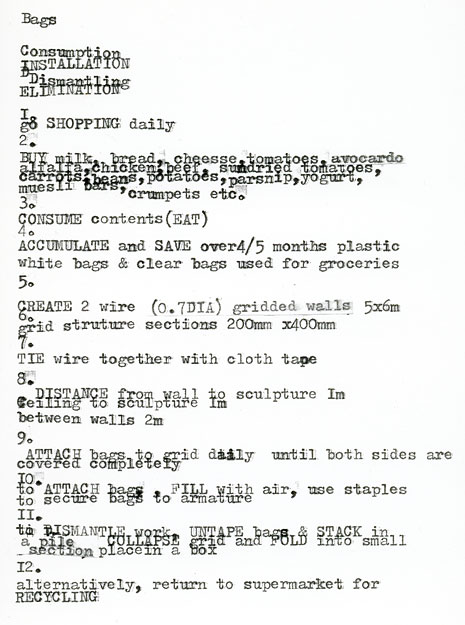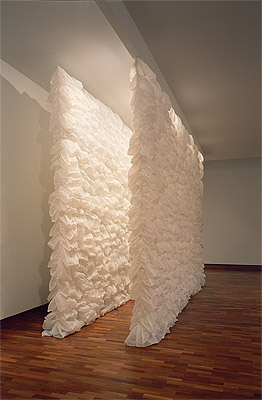Lauren
BERKOWITZ
Australia
1965
Bags
1994
polyethylene bags
installation(variable)
400 (h)
x 600 (w)
x 100 (d)
cm
Collection of the artist
© Lauren Berkowitz. Photographer: John Gollings
Lauren Berkowitz constructs equivocal spaces. Initially we approach Bags 1994 lured by its repeated forms, its downy white softness and apparent fragility; perhaps we sense also the promise of comfort and protection. Once within, however, we become aware of its claustrophobic qualities and potential to induce anxiety. This is a solid yet ethereal space, in which sound is muffled and yet light may enter. It is dreamlike, a little surreal, and as we pass between the walls, their tactile qualities evoke the visceral spaces of the body’s interior, perhaps even polyps magnified many times over. The hybrid nature of installation art―part theatre, part environment, part ephemeral―incorporates notions of space, and time, both present and future.
Bags demonstrates the continuing importance of anti-form and minimalist tendencies in the 1990s. Constructed from two walls of white, partially inflated plastic shopping bags over a suspended wire armature, Bags was first installed in the artist’s three-part exhibition Bags, bottles and newspapers in 1994.[1] Many hundreds of carefully cleaned and arranged bottles, used newspapers and bags formed the stuff of this show. The repetitive nature of the works echoes the endless cycle of shopping and consuming. The artist’s book, issued by Berkowitz at the time of the exhibition, comprises a set of postcards, with details of the three works accompanied by statements, badly typed.

Berkowitz’s methodical nature―she admits to keeping obsessive lists―imbues her projects with real intensity. In Times Square, New York, where the artist lived for a period in the early 1990s, she confronted visual overload, consumer abundance, and the seemingly mindless debris of human lives. Works such as Bags may signal the prevalence of non-perishable materials and single-use objects in our lives, an extension of the traditional memento mori to warn of the dangers of over-consumption. But as Anna Johnson points out, as well as raising serious environmental issues, Berkowitz achieves something more: we begin to understand the passion of one who hoards.[2] Bags is reliant on a network of friends and supporters; this is a time-consuming and slightly messy role, not an undertaking for a non-collector. It is also a work which is becoming increasingly difficult to make: as more and more bags take on a blue-grey or yellow-green hue, as a result of recycling, Berkowitz must increasingly search out the obsessive accumulators amongst us. Her transformation of our waste materials into this ambiguously beautiful, white installation is quite marvellous.
Lucina Ward
Curator,
International Painting and Sculpture
National Gallery of Australia, Canberra
[1] Bags, bottles and newspapers was at the Karyn Lovegrove Gallery, Melbourne, 18 August–17 September 1994. The work has subsequently been installed in two group shows: Blow up, Roslyn Oxley9 Gallery, Sydney, 31 May–24 June 1995; and in The infinite space: women, Minimalism and the sculptural object, The Ian Potter Museum of Art, University of Melbourne, 20 September–6 December 1998; see Natalie King, Blow up, Sydney: Roslyn Oxley9 Gallery 1995 and Rachel Kent, The infinite space: women, Minimalism and the sculptural object, The Ian Potter Museum of Art, University of Melbourne, 1998
[2] Anna Johnson, ‘Trash, treasure and hoarding’, in Australian Art Collector, issue 5, July–September 1998, pp 70–72, at p 72

